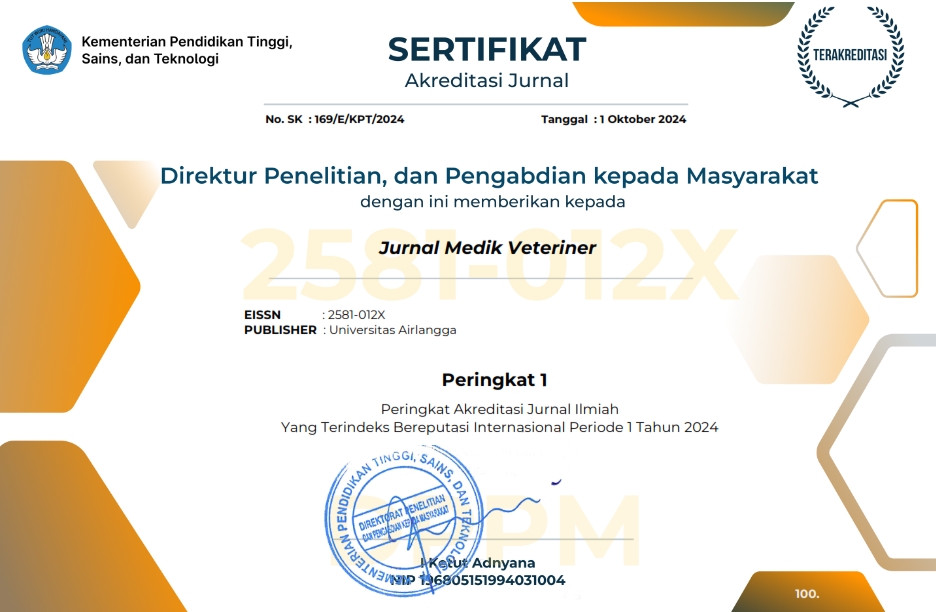Validation of Analytical Method for Aeromonas hydrophila Identification using Analytical Profile Index (API) 20E KIT Method

Downloads
The high demand for fish consumption has an impact on increasing aquaculture productivity and causes the vulnerability of increasing bacterial populations in aquaculture fields, so more rapid handling is needed. The use of phenotypic KIT methods (API 20E) has been applied as a targeted and efficient identification support in targeting better bacterial identification accuracy but often provides unequal results. Method validation is one of the general requirements for the competence of a laboratory evaluation: to provide coherent, interpretable, and accurate results with known uncertainties. The purpose of this study was to validate the API 20E KIT method for the identification of A. hydrophila. The conventional method used as a reference is SNI 7303.1:2015. The validation parameters consisted of determining the limit of detection, sensitivity, and specificity tests, as well as the positive predictive value and negative predictive value. The results showed that the limit of the detection value of the API 20E KIT was at a concentration of 100 CFU/mL with an ID of 99.00%. The sensitivity and specificity values in the positive and negative target samples were 100% with a positive predictive value and a negative predictive value of 0%, respectively. In conclusion, the API 20E KIT method as an alternative test method or rapid test was proven valid for identifying A. hydrophila by the test results using the reference method.
[Microbiological Method Committee]. (2011). Procedures for the development and management of food microbiological methods. Part 4: Guidelines for the Relative Validation of Indirect Qualitative Food Microbiological Methods. Canada.
[SNI] Indonesian National Standard 7303.1 (2015). Identification of Aeromonas hydrophila bacteria in fish - Part 1: Conventional method. National Standardization Agency, 1–14.
Al-Howaidi, M., & Al-Hamad, A. (2020). Comparison study between direct API 20E® identification of Gram-negative bacilli from positive blood cultures and bd phoenixTM identification performed from the colonies. Journal of Infection and Public Health, 13(2), 341–342.
Amano, M., Matsumoto, M., Sano, S., Oyama, M., Nagumo, H., Watanabe-Okochi, N., Tsuno, N. H., Nakajima, K., & Muroi, K. (2022). Characteristics of False-Positive Alarms in the BacT/Alert 3D System. Microbiology Spectrum, 10(3), 1–10.
AOAC. (2012). Official Methods of Analysis of AOAC International (19th ed.). Maryland, MD: AOAC International Press, pp: 61–91.
Awong-Taylor, J., Craven, K. S., Griffiths, L., Bass, C., & Muscarella, M. (2008). Comparison of biochemical and molecular methods for the identification of bacterial isolates associated with failed loggerhead sea turtle eggs. Journal of Applied Microbiology, 104(5), 1244–1251.
Ayunina, Y. Q. (2015). Verification Escherichia coli Commercial Test Kit on Tanjung Priok Animal Quarantine Laboratory Routine Sample. [Tesis]. IPB University, pp: 1–31.
Balcı, Åž., Ä°pek, Z. Z., Er, A., & Kayış, Åž. (2023). Comparison of the efficacy of two phenotypic identification kits and classic PCR methods to identify Aeromonas hydrophila isolated from fish farms. Aquatic Research, 6(2), 125–135.
Bodor, A., Bounedjoum, N., Vincze, G. E., Erdeiné Kis, Á., Laczi, K., Bende, G., Szilágyi, Á., Kovács, T., Perei, K., & Rákhely, G. (2020). Challenges of unculturable bacteria: environmental perspectives. Reviews in Environmental Science and Biotechnology, 19(1), 1–22.
Bottini, G., Losito, F, De Ascentis, A., Priolisi, FR., Mari, A., & Antonin, G. (2011). Validation of the micro biological survey method for total viable count and E.coli in food samples. American Journal of Food Technology, 6(11), 951–962.
Boyce, D. (2017). Evaluation of Medical Laboratory Tests. In Orthopaedic Physical Therapy Secrets: Third Edition (3rd ed.). Elsevier Inc. pp: 125–134.
Brady, C., Cleenwerck, I., Venter, S., Coutinho, T., & De Vos, P. (2013). Taxonomic evaluation of the genus Enterobacter based on multilocus sequence analysis (MLSA): Proposal to reclassify E. nimipressuralis and E. amnigenus into Lelliottia gen. nov. as Lelliottia nimipressuralis comb. nov. and Lelliottia amnigena comb. nov., respectively, E. gergoviae and E. pyrinus into Pluralibacter gen. nov. as Pluralibacter gergoviae comb. nov. and Pluralibacter pyrinus comb. nov. respectively. Systematic and Applied Microbiology, 36(5), 309–319.
Braga, P. A. C., Tata, A., Gonçalves Dos Santos, V., Barreiro, J. R., Schwab, N. V., Veiga Dos Santos, M., Eberlin, M. N., & Ferreira, C. R. (2013). Bacterial identification: From the agar plate to the mass spectrometer. RSC Advances, 3(4), 994–1008.
Christ, A. P. G., Ramos, S. R., Cayí´, R., Gales, A. C., Hachich, E. M., & Sato, M. I. Z. (2017). Characterization of Enterococcus species isolated from marine recreational waters by MALDI-TOF MS and Rapid ID API® 20 Strep system. Marine Pollution Bulletin, 118(1–2), 376–381.
Darmawan, B. D., & Rohaendi, O. E. (2014). Zoonosis : Infeksi penyaKit ikan terhadap manusia akibat kesalahan manajemen dan penanganan ikan maupun produk olahannya Zoonoses : The Infection of fish diseases on human due to management and handling errors of fresh and processed fish. Journal of Aquatropica Asia, 1, 2–9.
Desem, M. I., Handharyani, E., Setiyono, A., Safika, S., Subekti, D. T., & Ekawasti, F. (2023). Morphology, Biochemical, and Molecular Characterization of Pasteurella multocida Causing Hemorrhagic Septicemia in Indonesia. Veterinary Medicine International, 2023, 1–9.
Dubey, S., Maiti, B., Girisha, S. K., Das, R., Lamkhannat, M., Mutoloki, S., Chen, S. C., Karunasagar, I., Evensen, í˜., & Munang´andu, H. M. (2021). Aeromonas species obtained from different farmed aquatic species in India and Taiwan show high phenotypic relatedness despite species diversity. BMC Research Notes, 14(1), 1–8.
El-Son, M. A., Abdelkhalek, N. K., Zaki, V. H., & El-Ashram, A. M. (2019). Phenotypic and biochemical detection of Aeromonas hydrophila isolated from cultured Oreochromis niloticus during disease outbreaks. International Journal of Fisheries and Aquatic Studies, 7(3), 197–202.
Fernández-Bravo, A., & Figueras, M. J. (2020). An update on the genus Aeromonas: Taxonomy, epidemiology, and pathogenicity. Microorganisms, 8(1), 1–39.
Ferris, R. A., Palmer, B. A., Borlee, B. R., & McCue, P. M. (2017). Ability of Chromogenic Agar, MALDI-TOF, API 20E and 20 Strep Strips, and BBL Crystal Enteric and Gram-Positive IdentificationKITs to Precisely Identify Common Equine Uterine Pathogens. Journal of Equine Veterinary Science, 57, 35–40.
Fikri, F., Wardhana, D. K., Purnomo, A., Khairani, S., Chhetri, S., & Purnama, M. T. E. (2022). Aerolysin gene characterization and antimicrobial resistance profile of Aeromonas hydrophila isolated from milkfish (Chanos chanos) in Gresik, Indonesia. Veterinary World, 15(7), 1759.
Fikri, F., Purnomo, A., Chhetri, S., & Purnama, M. T. E. (2023). Sea Cucumber-Based Hydroxyapatite-Chitosan Ameliorate Serum Liver Enzymes and Cytokine Levels in Albino Rats with Femoral Bone Defect. Indian Veterinary Journal, 100(7), 23-26.
Gupta, R. K. (2014). Validation of Microbiological Methods – Expectations for Regulatory Compliance. BioPharma Asia, 3(September/October), 24–35.
ISO 16140-2. (2016). Protocol for the validation of alternative (proprietary) methods against a reference method. Geneva, Switzerland. pp: 66.
Jackson, E. E., & Forsythe, S. J. (2016). Comparative study of Cronobacter identification according to phenotyping methods. BMC Microbiology, 16(1), 1–10.
Jones, M., & Marengo, S. (2016). Laboratory validation, verification, and accreditation of molecular methods. Molecular Microbial Diagnostic Methods: Pathways to Implementation for the Food and Water Industries. Elsevier Inc. pp: 107–133.
Kazmi, M., Afshan, N., Un-Nisa, T., & Hassan, K. (2022). Evaluation of Indigenously Developed Quick Test Strip (QTS-24) with Foreign Compatible Product (API-20E). Proceedings of 2022 19th International Bhurban Conference on Applied Sciences and Technology, IBCAST 2022, 403–407.
Kusdarwati, R., Rozi, D Dinda, N., & Nurjanah, I. (2018). Antimicrobial resistance prevalence of Aeromonas hydrophila isolates from motile Aeromonas septicemia disease. IOP Conference Series: Earth and Environmental Science, 137(1), 1–6.
Leeflang, M. M. G., Rutjes, A. W. S., Reitsma, J. B., Hooft, L., & Bossuyt, P. M. M. (2013). Variation of a test's Sensitivity and Specificity with disease prevalence. CMAJ. Canadian Medical Association Journal, 185(11), 537 544.
Lukistyowati, I., & Kurniasih. (2012). Detection of aerolysin gen from Aeromonas hydrophila in common carp fed with garlic extract. Jurnal Veteriner, 13(1), 43–50.
Maina, D., Okinda, N., Mulwa, E., & Revathi, G. (2014). A five-year review of api20e bacteria identification system's performance at a teaching hospital. East African Medical Journal, 91(3), 73–76.
Mok, D., Nabulsi, R., & Chowdhury, S. (2018). Conformity evaluation checklists of API 20 E for ISO 15189:2012 internal auditing: An optimisation tool for medical laboratories. New Zealand Journal of Medical Laboratory Science, 72(3), 90–95.
Monaghan, T. F., Rahman, S. N., Agudelo, C. W., Wein, A. J., Lazar, J. M., Everaert, K., & Dmochowski, R. R. (2021). Foundational statistical principles in medical research: Sensitivity, specificity, positive predictive value, and negative predictive value. Medicina (Lithuania), 57(5), 0–6.
O'Hara, C. M., Tenover, F. C., & Miller, J. M. (1993). Parallel comparison of accuracy of API 20E, Vitek GNI, MicroScan Walk/Away Rapid ID, and Becton Dickinson Cobas Micro ID-E/NF for identification of members of the family Enterobacteriaceae and common Gram-negative, non- glucose-fermenting bacilli. Journal of Clinical Microbiology, 31(12), 3165–3169.
Peris"Vicente, J., Esteve"Romero, J., & Carda"Broch, S. (2015). Validation of Analytical Methods Based on Chromatographic Techniques: An Overview. Analytical Separation Science, 1757–1808.
Popović, N. T., Kepec, S., Kazazić, S. P., Strunjak-Perović, I., Bojanić, K., & ÄŒož-Rakovac, R. (2022). Identification of environmental aquatic bacteria by mass spectrometry supported by biochemical differentiation. PLoS ONE, 17(June 6), 1–13.
Pum, J. (2019). A practical guide to validation and verification of analytical methods in the clinical laboratory. In Advances in Clinical Chemistry (1st ed., Vol. 90). Elsevier Inc, pp: 253–259.
Rakotovao-Ravahatra, Z. D., Rahajamanana, L., Rakotondraoelina, L., Raskine, L., Rasoanandrasana, S., Rafalimanana, C., Rakotomalala, R., Rakotoarisoa, A. M., Andriambelo, L. V., Tantelinirimiarana, H., Fenomanana, J., Rakotoniaina, I., Ravaoarisaina, Z., Razafindrakoto, A. C., Ramavoson, T., Ramaminiaina, E., Randrianary, H., Razafinikasa, A. T., Ravelomandranto, J. E., & Rakotovao, A. L. (2021). Comparison of Bis NEG-D and API 20E for the Identification of Gram-negative Bacilli in the Laboratory of the University Hospital of Befelatanana Antananarivo Madagascar. European Journal of Biology and Biotechnology, 2(5), 76–80.
Rasmussen-Ivey, C. R., Figueras, M. J., McGarey, D., & Liles, M. R. (2016). Virulence factors of Aeromonas hydrophila: in the wake of reclassification. Frontiers in Microbiology, 7, 217548.
Robinson, A., McCarter, Y. S., & Tetreault, J. (1995). Comparison of Crystal Enteric/Nonfermenter system, API 20E system, and Vitek automicrobic system for identification of Gram-negative bacilli. Journal of Clinical Microbiology, 33(2), 364–370.
Safira, A., Rani, C. A. M., Puspitasari, R. A., Ayuningtyas, A. K. P., Mahendra, Y. A., Purnomo, A., Fikri, F., Chhetri, S., & Purnama, M. T. E. (2022). Amino Acid and Proximate Analysis of Type-1 Collagen from Sea Cucumber and Tilapia-Skin and its Potential Application as Artificial Tendon. Pharmacognosy Journal, 14(4).
Safira, A., Rani, C. A. M., Fikri, F., Purnomo, A., Khairani, S., Chhetri, S., Maslamama, S. T., & Purnama, M. T. E. (2023). Hydroxyapatite-chitosan composites derived from sea cucumbers and shrimp shells ameliorate femoral bone defects in an albino rat model. Veterinary World, 16(5).
Saleema, M., Amalina, M. Z., & Ina-Salwany, MY. (2018). The Effects of Inactivated Recombinant Cells Vaccine Encoding Outer Membrane Proteins (OMPs) of Aeromonas hydrophila in African Catfish, Clarias Gariepinus (Burchell, 1822). Progress in Aqua Farming and Marine Biology, 1(1), 1–15.
Santos, Y., Romalde, J. L., Bandín, I., Magariños, B., Núñez, S., Barja, J. L., & Toranzo, A. E. (1993). Usefulness of the API-20E system for the identification of bacterial fish pathogens. Aquaculture, 116(2–3), 111–120.
Singapore Accreditation Councils. (2019). Guidance Notes C&B AND ENV 002 Method Validation of Microbiological Methods. Enterprise Singapore, March, 1–11.
Stephan, R., Grim, C. J., Gopinath, G. R., Mammel, M. K., Sathyamoorthy, V., Trach, L. H., Chase, H. R., Fanning, S., & Tall, B. D. (2014). Re-examination of the taxonomic status of Enterobacter helveticus, Enterobacter pulveris and Enterobacter turicensis as members of the genus Cronobacter and their reclassification in the genera Franconibacter gen. nov. and Siccibacter gen. nov. as Franconibacter helveticus comb. nov., Franconibacter pulveris comb. nov. and Siccibacter turicensis comb. nov., respectively. International Journal of Systematic and Evolutionary Microbiology, 64, 3402–3410.
The FEM Microbiology Action Team. (2009). Method Validation of U.S. Environmental Protection Agency Microbiological Methods of Analysis. U.S. Environmental Protection Agency Office of Pesticide Programs Microbiology Laboratory Environmental Science Center, 1–16.
Tomas, D., Fan, M., Zhu, S., & Klijn, A. (2018). Use of biochemical miniaturized galleries, rRNA based lateral fl ow assay and Real Time PCR for Cronobacter spp. confirmation. Journal of Food Microbiology, 76(February), 189–195.
Travis, A. S. (2019). Biochemical and Culture-based Approaches to Identification in the Diagnostic Microbiology Laboratory. American Society for Clinical Laboratory Science, 32(4), 166–175.
Ugarte-Torres, A., Perry, S., Franko, A., & Church, D. L. (2018). Multidrug-resistant Aeromonas hydrophila causing fatal bilateral necrotizing fasciitis in an immunocompromised patient: A case report. Journal of Medical Case Reports, 12(1), 1–7.
Vetter, T. R., Schober, P., & Mascha, E. J. (2018). Diagnostic testing and decision-making: Beauty is not just in the eye of the beholder. Anesthesia and Analgesia, 127(4), 1085–1091.
Vira, H., Bhat, V., & Chavan, P. (2016). Diagnostic Molecular Microbiology and its applications: Current and Future Perspectives. Clinical Microbiology and Infectious Diseases, 1(1). 1–18.
Wahjuningrum, D., Hidayat, A. M., & Budiardi, T. (2018). Characterization of pathogenic bacteria in eel Anguilla bicolor bicolor. Indonesian Aquaculture Journal, 17(1), 94–103.
Wulandari, T., Indrawati, A., & Pasaribu, F. (2019). Isolation and Identification of Aeromonas hydrophila on Catfish (Clarias gariepinus) Farm Muara Jambi, Jambi Province. Jurnal Medik Veteriner, 2(2), 89–95.
Yeung, M., & Thorsen, T. (2016). Development of a more sensitive and specific chromogenic agar medium for the detection of vibrio parahaemolyticus and other vibrio species. Journal of Visualized Experiments, 2016(117), 1–9.
Copyright (c) 2024 Diah Artati, Mohammad Oman, Supriyanto Supriyanto, Dede Sukarta, Adam Robisalmi

This work is licensed under a Creative Commons Attribution-NonCommercial-ShareAlike 4.0 International License.
Authors who publish in this journal agree to the following terms:
1. The journal allows the author to hold the copyright of the article without restrictions;
2. The journal allows the author(s) to retain publishing rights without restrictions;
3. The legal formal aspect of journal publication accessibility refers to Creative Commons Attribution-NonCommercial-ShareAlike 4.0 International License (CC BY-NC-SA).






11.jpg)




















